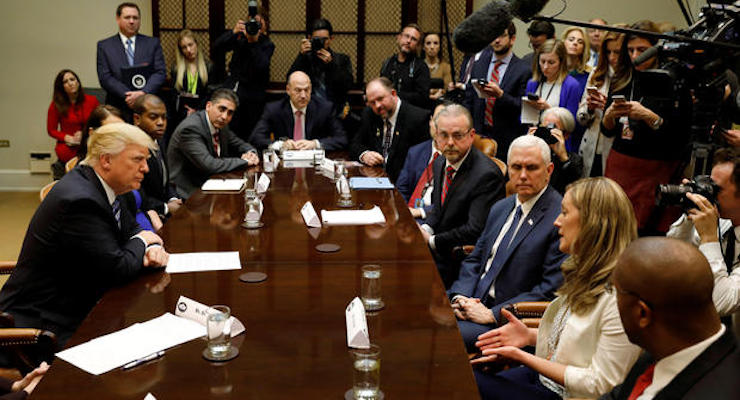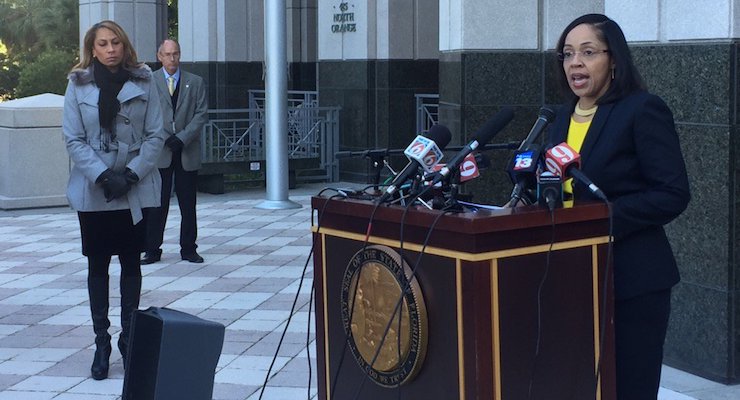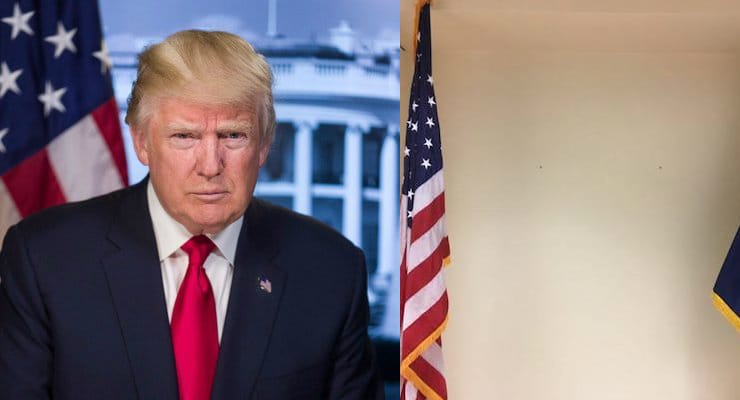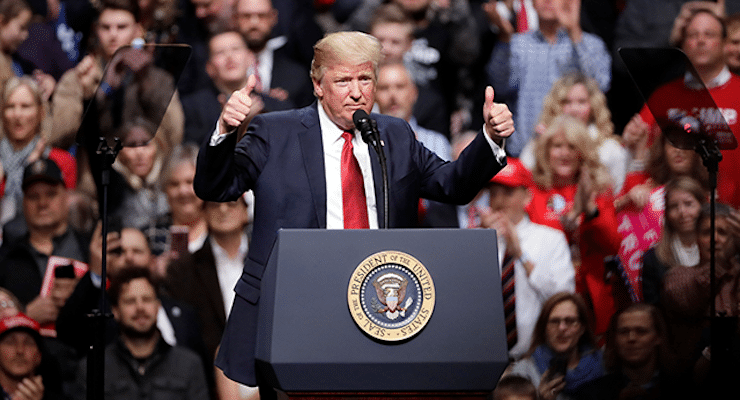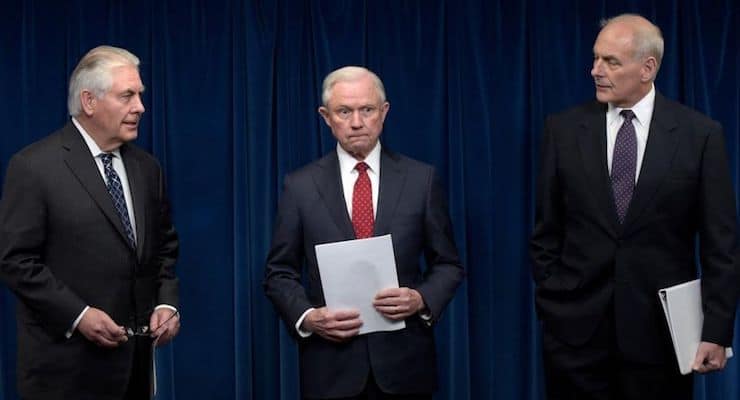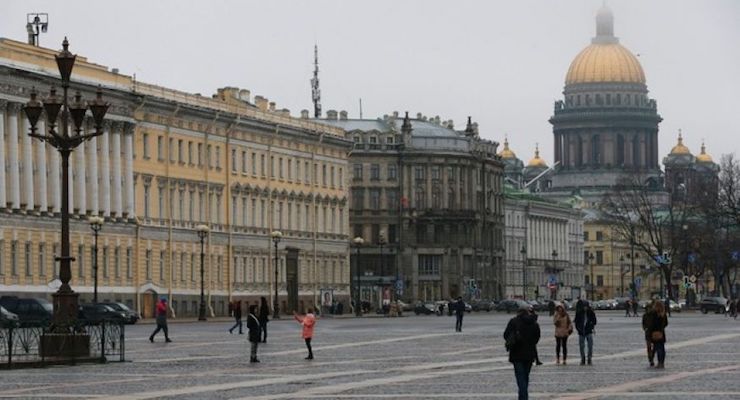
President Donald J. Trump speaks with Sailors in the hangar bay aboard Pre-Commissioning Unit Gerald R. Ford (CVN 78) on March 2, 2017. The president ,et with Sailors and shipbuilders of the Navy’s first-in-class aircraft carrier during an all-hands call inside the ship’s hangar bay. (Photo: Courtesy of U.S. Navy/Released)
President Trump has released his budget blueprint. From a big picture perspective, the size of government won’t change. He’s kicking the can down the road on entitlements, which is obviously disappointing for people who can add and subtract. He does cut some domestic programs, but taxpayers won’t reap the benefits since those savings will be spent elsewhere, mostly for a bigger Pentagon budget.
But I’m going to be optimistic today (the glass isn’t 9/10ths empty, it’s 1/10th full). Let’s look at the good parts of his budget.
First, some background.  Redistribution is bad public policy since it simultaneously encourages inactivity and dependency among recipients and discourages activity and initiative by taxpayers.
Redistribution is bad public policy since it simultaneously encourages inactivity and dependency among recipients and discourages activity and initiative by taxpayers.
That’s the standard argument against conventional handouts such as welfare, food stamps, Medicaid, EITC, and housing subsidies. The plethora of such programs in Washington is bad news for both taxpayers and poor people.
But there’s another type of redistribution that’s far worse, and that’s when politicians use the coercive power of government to take money from lower-income people in order to provide goodies for upper-income people.
This is why I am so unrelentingly hostile to programs like the Export-Import Bank, agriculture subsidies, so-called disaster relief, green-energy scams like Solyndra, and Fannie Mae/Freddie Mac subsidies.
 Indeed, I even developed a “Bleeding Heart Rule” back in 2012 to describe how such giveaways are morally reprehensible.
Indeed, I even developed a “Bleeding Heart Rule” back in 2012 to describe how such giveaways are morally reprehensible.
Now let’s add another program to the list.
The National Endowment of the Arts is a federal program that subsidizes art, with upper-income people reaping the vast majority of the benefits.
That’s the bad news. The good news is that President Trump is proposing to defund this elitist bureaucracy.
Before explaining why the program should be abolished, let’s look at the case for federal involvement. This is how the NEA describes its mission.
The National Endowment for the Arts is an independent federal agency that funds, promotes, and strengthens the creative capacity of our communities by providing all Americans with diverse opportunities for arts participation.
That sounds noble. But are we really supposed to believe that our communities won’t have any creative capacity without some handouts from the federal government to museums and other politically connected organizations that primarily serve rich people?
And for those of us who have this old-fashioned notion that the federal government should be constrained by the Constitution, it’s also worth noting that art subsidies are not one of the enumerated powers in Article 1, Section 8.
Here is the pro-NEA argument from a column in the New York Times.
Sadly, it has become clear that the N.E.A. is, once again, under threat of being abolished… The N.E.A.’s budget is comparatively minuscule — $148 million last year, or 0.004 percent of the total federal budget — while the arts sector it supports employs millions of Americans and generates billions each year in revenue and tax dollars. …the N.E.A., founded in 1965, serves three critical functions: It promotes the arts; it distributes and stimulates funding; and it administers a program that minimizes the costs of insuring arts exhibitions through indemnity agreements backed by the government. …The grants, of course, receive the most attention, if not as much as they deserve. Thousands are distributed in all 50 states, reaching every congressional district, urban and rural, rich and poor. …They support live theater for schools; music, dance and jazz festivals; poetry and literary events; arts programs for war veterans; and, of course, museum exhibitions.
This actually makes my point. The NEA spends $148 million per year, which is just a tiny fraction of what is spent by the private sector.
In other words, we had museums, plays, music festivals, and art programs before the NEA was created and all of those activities will exist if the NEA is abolished.
All that will change is that politicians and bureaucrats won’t be doling out special grants to select institutions and insiders that have figured out how the manipulate the system.
The column also has some absurd hyperbole.
I fear that this current call to abolish the N.E.A. is the beginning of a new assault on artistic activity. Arts and cultural programming challenges, provokes and entertains; it enhances our lives. Eliminating the N.E.A. would in essence eliminate investment by the American government in the curiosity and intelligence of its citizens.
The author actually wants readers to conclude that a failure to subsidize is somehow akin to an assault on artistic creativity. Oh, and don’t forget that our curiosity and intelligence somehow will suffer.
Here’s a story about an interest group that wants to keep the gravy train on the tracks.
The heads of five Boston arts museums are pushing back against feared Trump administration cuts to the National Endowment for the Arts and the National Endowment for the Humanities. The museums’ directors say in an open letter that the agencies…help foster knowledge of the arts, create cultural exchanges, generate jobs and tourism, and educate young people. They say NEA and NEH funding has been instrumental at each of the Boston museums.
My immediate reaction is that there are lots of rich people and well-heeled companies in Boston. Surely NEA handouts can be replaced if these museum directors are remotely competent.
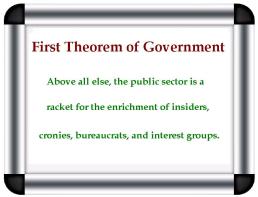 I’ll also take a wild guess that the directors of these five museums earn an average of more than $500,000 per year. Perhaps it’s not right for them to be using tax dollars to be part of the top 1 percent. Heck, trimming their own salaries might be an easy place for them to get some cost savings.
I’ll also take a wild guess that the directors of these five museums earn an average of more than $500,000 per year. Perhaps it’s not right for them to be using tax dollars to be part of the top 1 percent. Heck, trimming their own salaries might be an easy place for them to get some cost savings.
But enough from me. Let’s look at what some others have written about the NEA. Let’s start with George Will’s assessment.
…attempting to abolish the NEA is a fight worth having, never mind the certain futility of the fight. …Government breeds advocacy groups that lobby it to do what it wants to do anyway — expand what it is doing. The myriad entities with financial interests in preserving the NEA cloyingly call themselves the “arts community,” a clever branding that other grasping factions should emulate… The “arts community” has its pitter-patter down pat. The rhetorical cotton candy — sugary, jargon-clotted arts gush — asserts that the arts nurture “civically valuable dispositions” and a sense of “community and connectedness.” And, of course, “diversity” and “self-esteem.” Americans supposedly suffer from a scarcity of both. …the NEA’s effects are regressive, funding programs that are…“generally enjoyed by people of higher income levels, making them a wealth transfer from poorer to wealthier.” …Americans’ voluntary contributions to arts organizations (“arts/culture/humanities” institutions reaped $17 billion in 2015) dwarf the NEA’s subventions, which would be replaced if those who actually use the organizations — many of them supported by state- and local-government arts councils — are as enthusiastic about them as they claim to be. The idea that the arts will wither away if the NEA goes away is risible.
Now let’s hear from members of the “arts community” who understand that art doesn’t require handouts.
We’ll start with Patrick Courrielche, who wrote in the Wall Street Journal about the need to free the arts from federal dependence.
The NEA, created in 1965, has become politically tainted and ill-equipped to handle today’s challenges. Mr. Trump and Congress should ax it as soon as possible. …For the American arts to flourish—and for art to reach all Americans—artists must be able to make a living from their efforts.
And a theater director from Brooklyn explains in the Federalist why the art world will be better off without the NEA.
…as Trump prepares to spike the ball and end the game by axing the NEA, there is reason to be optimistic that this decision will be very good for the arts in America. …Arts institutions, which receive the bulwark of NEA funding, are failing badly at reaching new audiences, and losing ground. This is a direct result of the perverse market incentives our nonprofit arts system creates… As the artistic director of an unsubsidized theater company in New York City for more than a decade, I had to compete in a closed marketplace, where wealthy gatekeepers and the government rather than ticket sales pay the bills. …The industry receives more free money than it did a decade ago, and has fewer attendees. That is a broken system by any estimation. …Taking away free government money for the arts won’t make art disappear. After all, art is older than government. It will force artists and arts organizations to finally come to terms with their market realities. Audiences are better than experts at deciding what art is good or important. If a piece of art is so good that nobody to wants to pay for it, maybe it isn’t all that good. …In the American tradition, vaudeville, jazz, standup comedy, and many other art forms were created and grew within the free market, free from government assistance. Under this system there was a tremendous appetite for high art among Americans… President Trump is wise to get the government out of the art game, and all of us will be better off for his decision.
Here’s another artist, writing for PJ Media, about the benefits of ending federal handouts.
For over a decade as a theatre artist, my salary was made possible by taxpayers funding the arts. …In hindsight, and after much reflection and a better understanding of economics, I am truly sorry, and ask the taxpayer to forgive my thievery. However, spilled milk can’t be put back into the bottle. That doesn’t mean that we have to keep spilling the milk, though. It’s way past time to defund and shutter the National Endowment for the Arts.  … The NEA and their supporters will trot out research about how many dollars are added to local economies due to things like theatres, symphonies, and museums. Of course, as almost every person with at least half a semester of Economics under their belt is screaming, the NEA’s argument embraces the broken window fallacy. The economic stimulus felt and supposedly generated by the arts community comes at the expense of other markets. …The National Endowment for the Arts model artificially props up mostly unwanted markets by using tax dollars that get funneled through inefficient and wasteful bureaucracies. …What it does to the arts is create a marketplace that supports bad art. …Don’t misunderstand, I love art. Like, a lot. And I’m willing to pay for it, as are many other patrons of the arts. If the National Endowment for the Arts were to be defunded and shuttered, it would help clear the deck of bad art that people aren’t willing to pay the real cost for. …art does enhance life, but having your life enhanced at the expense of others is not a right. People don’t have a right to other people’s money just so they can watch a play or visit a museum. …It’s time for the National Endowment for the Art to be defunded and shuttered.
… The NEA and their supporters will trot out research about how many dollars are added to local economies due to things like theatres, symphonies, and museums. Of course, as almost every person with at least half a semester of Economics under their belt is screaming, the NEA’s argument embraces the broken window fallacy. The economic stimulus felt and supposedly generated by the arts community comes at the expense of other markets. …The National Endowment for the Arts model artificially props up mostly unwanted markets by using tax dollars that get funneled through inefficient and wasteful bureaucracies. …What it does to the arts is create a marketplace that supports bad art. …Don’t misunderstand, I love art. Like, a lot. And I’m willing to pay for it, as are many other patrons of the arts. If the National Endowment for the Arts were to be defunded and shuttered, it would help clear the deck of bad art that people aren’t willing to pay the real cost for. …art does enhance life, but having your life enhanced at the expense of others is not a right. People don’t have a right to other people’s money just so they can watch a play or visit a museum. …It’s time for the National Endowment for the Art to be defunded and shuttered.
Amen.
Since I started today’s column with optimism, I’ll be balanced and end with pessimism. I very much doubt that Congress will defund the NEA bureaucracy.
In part, this is a classic example of “public choice.” The recipients of the handouts have strong incentives to mobilize and lobby to keep their goodies. Taxpayers, by contrast, mostly will be disengaged because their share of the cost is trivial.
But it gets worse. The NEA also is very clever. A Senator once told me that it was difficult to vote against the bureaucracy because the “arts community” cleverly placed the wives of major donors on local arts councils. That made it difficult to vote against the NEA, though this Senator did say that making this tough vote would be worthwhile. Yes, there would be some short-term grousing by interest groups (and donor wives) if the agency actually was shut down, but that would quickly dissipate as people saw the arts were able to survive and thrive without sucking at the federal teat.
For the sake of the nation, let’s hope most lawmakers think this way.
President Trump has released his budget blueprint.
